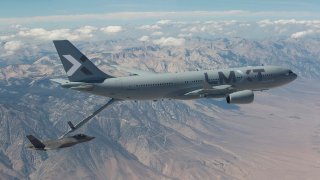LMXT: How Lockheed Martin and Airbus Could Move Fast
The plan aims to integrate a proven airframe with state-of-the-art military technology.
Lockheed Martin and Airbus are moving quickly on a collaborative plan to build the Air Force’s new LMXT KC-Y “bridge tanker” through an integrated commercial and military developmental process.
As a way to accommodate the Air Force’s need to quickly produce a “bridge” tanker until the KC-46 arrives in sufficient numbers, developers are basing the LMXT on the successful Airbus A330 Multi Role Tanker Transport. In addition to ensuring that the aircraft can be mass produced on the rapid timeframe needed by the Air Force, this effort also helps build in interoperability and what’s often referred to as “open architecture.” Open architecture is a technical effort to build aircraft with common standards, allowing them to be quickly upgraded as new technologies emerge.
Much of this can be accomplished through common IP Protocol standards and software upgrades that enable avionics, onboard computing, and sensor technologies to receive rapid updates that improve performance and ensure that the aircraft can interoperate across multiple domains in joint operations.
As Airbus has a recent history of building advanced commercial aircraft like the A320 and A220 airliners, Lockheed sees an opportunity to leverage this production infrastructure. Once the airframes and integrated commercial technologies are completed at the Airbus facility in Mobile, Alabama, they will go to Lockheed’s facility in Marietta, Georgia to be converted from a commercial aircraft into the militarized LMXT tanker.
The plan is a byproduct of a multi-year memorandum of agreement that was signed in 2018. The collaborative effort, Lockheed developers say, aims to integrate a proven airframe currently used by allies around the globe with state-of-the-art military technology.
“Lockheed Martin's presence in northern Alabama spans more than five decades, with a concentration in the rotorcraft and hypersonics sectors. More than 2,600 Lockheed Martin employees live and work in Alabama. In October 2021, Lockheed Martin opened an advanced production facility in Courtland focused on hypersonic strike production,” a Lockheed statement said.
Part of the rationale for the two-phase building strategy is to optimize the best value from both Airbus and Lockheed before fully integrating them into a single air platform. The Lockheed-Airbus manufacturing team is likely looking to leverage the substantial expertise held by the workforces in Marietta and Mobile.
Kris Osborn is the Defense Editor for the National Interest. Osborn previously served at the Pentagon as a Highly Qualified Expert with the Office of the Assistant Secretary of the Army—Acquisition, Logistics & Technology. Osborn has also worked as an anchor and on-air military specialist at national TV networks. He has appeared as a guest military expert on Fox News, MSNBC, The Military Channel, and The History Channel. He also has a Master's Degree in Comparative Literature from Columbia University.
Image: Reuters

